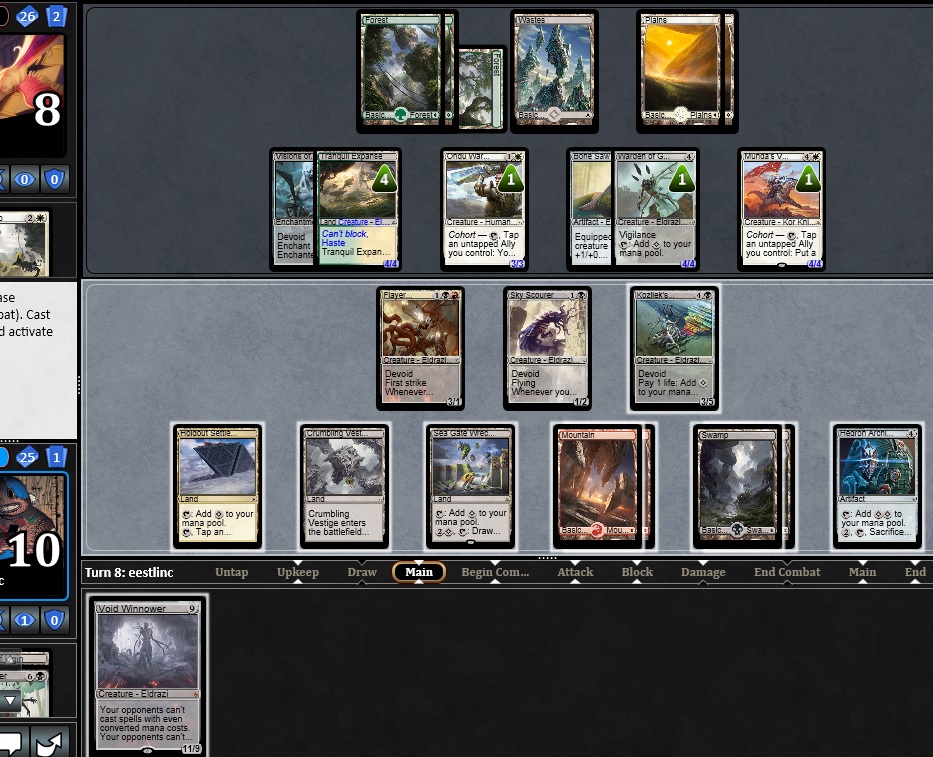Last week I gushed about Selesnya Support in Oath of the Gatewatch draft. BORING, you say. Fair enough. Winning can be boring. Also, now that the secret’s out, the support cards aren’t circling the table so freely. I jammed eight Oath-Oath-Battle drafts over the weekend in the online 8-4 queues. Not a single time did I draft green-white. That’s because I read the table, and the cards stopped showing up.
Draft is a constantly evolving metagame—one that’s much less understood than in constructed formats. The best way to draft is to take cards that are being undervalued. That is dynamic, so you have to stay ahead of the game. Draft picks are like financial markets—the going price for specific cards fluctuates as players learn more about the set and develop deeper experience with card interactions.
There’s no TCG Mid for draft values, though. People like to read pick order lists, which can provide brief snapshots of how one team valued each card for a specific weekend. But these data points are like checking historical prices for similar sales when valuing a complex financial instrument. They help define the ballpark, but they’re more like partial maps of potential hazards than a defined path to success. Published pick order lists rarely come close to approximating the collective valuation of the universal draft pod.
So how do you figure out what the undervalued cards will be in your draft? If you play with a regular group of drafters, you can study their tendencies and listen to the chatter between drafts. For example, I know that if blue-green is a good archetype in any given draft format, Hugh Kramer will know how to draft it to perfection before you even realize it’s good. He will show you when it is good. That information is useful, say when you get together with Hugh and crew for an OG Modern Masters flashback draft—I have a box and I’m coming to town, just saying—but this information provides at best a partial view of how the draft will play out. If you happen to be sitting to Craig Wescoe’s left, you might want to value white cards a little less than you otherwise would. Don’t expect Gurmag Swiftwing to wheel either, btw. But I digress.
Most competitive drafts pit you against relatively unknown pods. You can go into a draft knowing some of the prevailing winds for pick orders and card priorities, but most of the information about what your draftmates value will come from the cards you are passed in the draft itself. Your valuation skills will be put to the test in real time. That’s one of the best things about drafting at a high level, and the players who gravitate toward limited often do because they love the challenging of assembling “card prices” on the fly.
“Staying open” is a mantra of many great drafters. It’s not just about figuring out which archetype is not being drafted by anyone else at the table, though. It applies to the metagame as well. I had a free weekend to channel some focused energy into Oath draft on Magic Online. Going in, I had a sense of how people had valued draft cards and archetypes coming out of the Pro Tour. But I was excited to see what had changed.
Here’s an amazing deck I pulled together through skilled table reading and piloted to a very challenging and rewarding 3-0 record:
Rakdos Raredraft
This is about as far from Selesnya Support as one can get. I had messed with Rakdos Devoid before, but they felt like mediocre midrange decks that had a narrow window to victory before my opponents shut down the attack lanes. You want to lean on Zada’s Commando and Zulaport Chainmage to close the door, but those cards do not fit nicely in the same deck as Flayer Drone and Kozilek’s Shrieker.
What if you only play devoid cards? It turns out you can pick up a lot of Sky Scourers if black-red is open at your table. I left my fifth copy in the sideboard. The real challenge to the deck is assembling a mana base that allows you to curve out but lets you leverage colorless activated abilities on cards like Havoc Sower, Maw of Kozilek, Slaughter Drone, Kozilek’s Shrieker, and Essence Depleter. Crumbling Vestige is the all star land you want, and you should take them highly if you go down the Rakdos path.
I happened to be lucky to get passed both Sea Gate Wreckage and Sanctum of Ugin. The wreckage is a broken card in an aggressive deck with enough colorless sources. I’d consider first picking Sea Gate Wreckage with the goal of drafting an aggressive devoid deck. You don’t get any colors for mana fixing off it, but it provides so much value when your game plan is to dump your hand early and refill late. Sanctum of Ugin is much narrower, but if you happen to pick up even one seven-plus mana eldrazi in a deck of all colorless creatures, it’s a Wastes that doubles as a free tutor.
I didn’t run Void Winnower in my main deck because I wanted to present a more streamlined plan game one. Dread Defiler is big enough to push over the top in some matchups. Triggering Sanctum of Ugin off it to grab a Flayer Drone or Havoc Sower was plenty good enough. But in my first two rounds, I ran into grindy decks that required me to bring in some reinforcements from the sideboard:

That’s a way to turn around a game where Munda’s Vanguard is getting out of hand. It took a few turns to win from here, but even Oblivion Strike probably doesn’t do enough to get me out of this position. How am I blocking a 5/5 vigilant Warden of Geometries wearing a Bone Saw? Bet you’ve never had to answer that question before!
I learned that black-red devoid is not a high-priority archetype. Reading the table in each draft, it was open for me three times out of eight. This was the third, and I learned from the first two what I could bank on wheeling. And I learned that being able to pick a rare colorless land early and know how to put it to best use opens a ton of value for you. Most players struggle to place lands in their pick orders and only take them when they don’t have to pass anything too good. By knowing how to maximize rare lands, you can gain an edge in the draft.
Here’s a different take on devoid, this time Izzet. It’s more of a devoid-surge hybrid, but the common theme was cheap cards that do things in the late game.
Surge of Devoid
This time I ended up with much fewer rares. Some of that is my fault, as I recall noticing that the dual land in the middle of pack two was Wandering Fumarole, not Cinder Barrens, after I had double-clicked on my second Cultivator Drone. Oops.
Pyromancer’s Assault impressed me greatly. I used it to good effect to out-grind a Baloth Null deck, which is no small feat. Prophet of Distortion is simply amazing in this strategy. You need to draw extra cards to cast two spells regularly. We can’t all get passed Jori En, Ruin Diver, after all. The one matchup where I sided out the assault was actually against the mirror in the finals. I found my opponent’s creatures had too much toughness (they had Radiant Flames), so I had to look for more efficient options. They also had Chanra, Flamecaller, so Negate was one of those options. Cloud Manta and Wave-Wing Elemental also chipped in to finish off this 3-0.
My biggest lesson from drafting Izzet Devoid/Surge? The deck is less open than Rakdos devoid. It won’t always come to you, and you have to cobble together the right pieces. Be prepared to prioritize valuable one and two drops, and any ways to draw extra cards. Prophet of Distortion is the truth. Also, I kinda like sideboarding in Consuming Sinkhole or Volcanic Upheaval. Don’t tell anyone!
Carrie O’Hara is Editor-in-Chief of Hipsters of the Coast.


